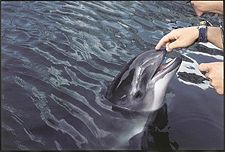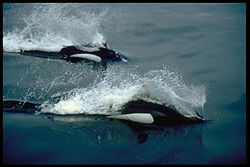Difference between revisions of "Porpoise" - New World Encyclopedia
Rick Swarts (talk | contribs) |
Rick Swarts (talk | contribs) |
||
| Line 46: | Line 46: | ||
Recently-discovered [[hybrid]]s between male Harbour porpoises and female Dall's Porpoises indicate that the two species may actually be members of the same [[genus]] (Read 1999). | Recently-discovered [[hybrid]]s between male Harbour porpoises and female Dall's Porpoises indicate that the two species may actually be members of the same [[genus]] (Read 1999). | ||
| − | ==Types and | + | ==Types, taxonomy and distribution== |
| + | |||
| + | The six species of porpoises typically recognized are Burmeister's porpoise (''Phocoena spinipinnis''), Dall's porpoise (''Phocoenoides dalli''), finless porpoise (''Neophocaena phocaenoides''), harbour porpoise (''Phocoena phocoena''), spectacled porpoise (''Australophocaena dioptrica'' or ''Phocoena dioptrica''), and vaquita (''Phocoena sinus''). One taxonomy is as follows: | ||
| + | |||
* '''ORDER CETACEA''' | * '''ORDER CETACEA''' | ||
** '''Suborder [[Mysticeti]]''': Baleen whales | ** '''Suborder [[Mysticeti]]''': Baleen whales | ||
| Line 60: | Line 63: | ||
**** Genus ''[[Phocoenoides]]*'' | **** Genus ''[[Phocoenoides]]*'' | ||
***** [[Dall's Porpoise]]*, ''Phocoenoides dalli'' | ***** [[Dall's Porpoise]]*, ''Phocoenoides dalli'' | ||
| + | |||
| + | From: WDCS 2007. Whale and Dolphin Conservation Society | ||
| + | http://www.wdcs.org/dan/publishing.nsf/allweb/A5343454B1CC4C0C802568F8004E6921 | ||
| + | |||
| + | Burmeister's proposises temperate and sub-antarctic coastal waters of southern South America | ||
| + | Dall's poropoise — warm temperate to sub-arctic waters of the North Pacific Ocean | ||
| + | Finless porpoises — 3 varieties | ||
| + | ONe in Yangtze River, China | ||
| + | one is coastal waters around Japan and Kora | ||
| + | third in coastal and riverine waters in other parts of Asia, | ||
| + | |||
| + | Harbour porpoise — coastal waters of subarctic and cool temperate wates of the North Atlantic and the North Pacific | ||
| + | only member found in Euroean waters | ||
| + | |||
| + | |||
| + | |||
| + | Spectacles porpoise — various places, most foundin southern Atlantic coast of Suoth America | ||
| + | |||
| + | Vaquitas — smallest distribution of marine cetaceans, live in norther end of the Gulf of Californi (Sea of Cortez) within a 30 mile radius. ON brink of extinction and numbers somewhere between 100 and 500 | ||
| + | |||
| + | http://www.wdcs.org/dan/publishing.nsf/allweb/A5343454B1CC4C0C802568F8004E6921 | ||
==Lifecycle and behavior== | ==Lifecycle and behavior== | ||
Revision as of 02:29, 26 March 2007
| Porpoises
| ||||||||||
|---|---|---|---|---|---|---|---|---|---|---|
 Phocoena phocoena, Harbour Porpoise
| ||||||||||
| Scientific classification | ||||||||||
| ||||||||||
|
Neophocaena |
The porpoises are small, marine cetaceans of the family Phocoenidae. Porpoises belong to the "toothed whales" suborder Odontoceti, along with whales and dolphins.
Although scientifically, the term porpoise should be reserved for members of the family Phocoenidae, historically the term has been often applied in common venacular to any small cetacean, especially by sailors and fishermen (Grzimek 2004).
Porpoises, divided into six species, live in all oceans, mostly near the shore. Probably best known is the Harbour Porpoise, which can be found across the Northern Hemisphere.
Description
As mammals, cetaceans are warm-blooded, breathe air, and feed their young on milk. Porpoises all give birth to live young. Like mammals, porpoises have hair at least some stage in their development, but are nearly hairless, like other cetaceans. They also share with other cetaceans a fusiform (spindle-shaped) body with anterior limbs in the form of flippers, and a flat, notched tail with horizontal flukes that lacks bony support.
Like other members of the Odontoceti suborder, porpoises have only one blowhole and have the main bones of the upper jaw thrust upward and back over the eye sockets (Grzimek 2004). An outstanding ability of the Odontoceti is to sense their surrounding environment through echolocation.
In common use, the term porpoise is often applied to dolphins. There is no strict definition of the term dolphin (Grzimek 2004). Generally, the term has been used either for members of the family Delphinidae or for any member of the families Delphinidae and Platanistoidea.
Porpoises tend to be smaller but stouter than dolphins. They have small, rounded heads and blunt jaws instead of beaks like the Delphinidae. While dolphins in the Delphinidae typically have a round, bulbous "melon", porpoises do not. Their teeth are flattened and spade-shaped, whereas dolphins have conical teeth.
In addition, a porpoise's dorsal fin is generally triangular, rather than curved like that of many dolphins and large whales. (Some Delphinidae and Phocoenidae lack dorsal fins.) Some species have small bumps, known as tubercles, on the leading edge of the dorsal fin. The function of these bumps is unknown (Read 1999).
These animals are the smallest cetaceans, reaching body lengths up to 2.5 m (8 feet); the smallest species is the Vaquita, reaching up to 1.5 m (5 feet). In terms of weight the lightest is the Finless Porpoise at 30-45 kg (65-100 lb) and the heaviest is Dall's Porpoise at 130-200kg (280-440 lb). Porpoises are intelligent and friendly mammals. Because of their small size, porpoises lose body heat to the water more rapidly than other cetaceans. Their stout shape, which minimizes surface area, may be an adaptation to reduce heat loss. Thick blubber also insulates them from the cold. The small size of porpoises requires them to eat frequently, rather than depending on fat reserves (Read 1999).
Porpoises, along with whales and dolphins, are descendants of land-living mammals and are related to hoofed animals. They entered the water roughly 50 million years ago.
Recently-discovered hybrids between male Harbour porpoises and female Dall's Porpoises indicate that the two species may actually be members of the same genus (Read 1999).
Types, taxonomy and distribution
The six species of porpoises typically recognized are Burmeister's porpoise (Phocoena spinipinnis), Dall's porpoise (Phocoenoides dalli), finless porpoise (Neophocaena phocaenoides), harbour porpoise (Phocoena phocoena), spectacled porpoise (Australophocaena dioptrica or Phocoena dioptrica), and vaquita (Phocoena sinus). One taxonomy is as follows:
- ORDER CETACEA
- Suborder Mysticeti: Baleen whales
- Suborder Odontoceti: toothed whales
- Family Phocoenidae: Porpoises
- Genus Neophocaena
- Finless Porpoise, Neophocaena phocaenoides
- Genus Phocoena
- Spectacled Porpoise, Phocoena dioptrica
- Harbour Porpoise, Phocoena phocaena
- Vaquita, Phocoena sinus
- Burmeister's Porpoise, Phocoena spinipinnis
- Genus Phocoenoides
- Dall's Porpoise, Phocoenoides dalli
- Genus Neophocaena
- Family Phocoenidae: Porpoises
From: WDCS 2007. Whale and Dolphin Conservation Society http://www.wdcs.org/dan/publishing.nsf/allweb/A5343454B1CC4C0C802568F8004E6921
Burmeister's proposises temperate and sub-antarctic coastal waters of southern South America Dall's poropoise — warm temperate to sub-arctic waters of the North Pacific Ocean Finless porpoises — 3 varieties
ONe in Yangtze River, China
one is coastal waters around Japan and Kora third in coastal and riverine waters in other parts of Asia,
Harbour porpoise — coastal waters of subarctic and cool temperate wates of the North Atlantic and the North Pacific only member found in Euroean waters
Spectacles porpoise — various places, most foundin southern Atlantic coast of Suoth America
Vaquitas — smallest distribution of marine cetaceans, live in norther end of the Gulf of Californi (Sea of Cortez) within a 30 mile radius. ON brink of extinction and numbers somewhere between 100 and 500
http://www.wdcs.org/dan/publishing.nsf/allweb/A5343454B1CC4C0C802568F8004E6921
Lifecycle and behavior
Porpoises are relatively r-selected compared with dolphins: that is, they rear young more quickly than dolphins. Female Dall's and Harbour Porpoises often become pregnant with a single calf each year, and pregnancy lasts for about 11 months. Although the lifespan of most species is not known, specimens older than in their mid-teens have rarely been found.[1]
Porpoises are predators of fish, squid, and crustaceans. Although they are capable of dives up to 200 m, they generally hunt in shallow coastal waters. They are found most commonly in small groups of fewer than ten individuals. Rarely, some species form brief aggregations of several hundred animals. Like all toothed whales they are capable of echolocation for finding prey and group coordination. Porpoises are fast swimmers—Dall's porpoise is said to be one of the fastest cetaceans, with a speed of 55 km/h (15 m/s).
Unlike the delphinids, which often leap out the water and bow-ride on the wave of a ship, phocoenids rarely are observed doing this. Porpoises tend to be less acrobatic and more wary than dolphins.
Human impact
Accidental entanglement (bycatch) in fishing nets is the main threat to porpoises today. One of the most endangered cetacean species is the Vaquita, having a limited distribution in the Gulf of California, a highly industrialized area.[2]
In some countries, porpoises are hunted for food or bait meat.
Porpoises are rarely held in captivity in zoos or oceanaria, as they are generally not as capable of adapting to tank life nor as easily trained as dolphins.
See also
ReferencesISBN links support NWE through referral fees
- ↑ Cite error: Invalid
<ref>tag; no text was provided for refs namedread - ↑ The Porpoise Page - Information on Porpoises. Retrieved 2006-11-03.
- Grzimek, B., D. G. Kleiman, V. Geist, and M. C. McDade. 2004. Grzimek's Animal Life Encyclopedia. Detroit: Thomson-Gale. ISBN 0787657883.
| Cetaceans | |
|---|---|
| Suborder Mysticeti (baleen whales) |
Eschrichtiidae (gray whales) · Balaenopteridae (rorquals) · Balaenidae (right whales) · Neobalaenidae (pygmy right whales) |
| Suborder Odontoceti (toothed whales) |
Platanistoidea (river dolphins) · Delphinidae (oceanic dolphins) · Phocoenidae (porpoises) · Monodontidae (beluga and narwhal) · Physeteridae (sperm whales) · Kogiidae (pygmy and dwarf sperm whales) · Ziphiidae (beaked whales) |
Credits
New World Encyclopedia writers and editors rewrote and completed the Wikipedia article in accordance with New World Encyclopedia standards. This article abides by terms of the Creative Commons CC-by-sa 3.0 License (CC-by-sa), which may be used and disseminated with proper attribution. Credit is due under the terms of this license that can reference both the New World Encyclopedia contributors and the selfless volunteer contributors of the Wikimedia Foundation. To cite this article click here for a list of acceptable citing formats.The history of earlier contributions by wikipedians is accessible to researchers here:
The history of this article since it was imported to New World Encyclopedia:
Note: Some restrictions may apply to use of individual images which are separately licensed.
- ↑ Read, Andrew (1999). Porpoises. Stillwater, MN, USA: Voyageur Press.
